How an airplane toilet works at 40,000 feet: The extraordinary science behind everyday flying
How do you connect to the internet while barreling through the sky at 500 miles per hour? How can you brew hot food and drinks at high altitude? And most important of all, how does a toilet work at 40,000 feet?
We often think about how planes work – how they get into the air, and stay there safely. What we think about less are the everyday functions taking place on onboard. Air circulation, heating food and drinks, even flushing the lavatory – it turns out that the more mundane the activity is, the harder it gets to perform it in the air.
“It’s pretty remarkable when you start to dig deep,” says Al St. Germain, an aviation industry consultant who’s worked for airlines including Delta and United.
“With almost anything on an aircraft, you realize how much goes into it from an engineering perspective – even just getting a meal. Everything is twice as hard on a plane as on the ground.”
While safety has always been the driving force for airlines, and the industry’s current buzzword is sustainability (or, rather, making flying less destructive for the environment), St. Germain says that passenger experience, often known as “paxex,” can be what makes travelers pick one airline over another. So how do airlines make magic happen in the air?
Toilets in the sky
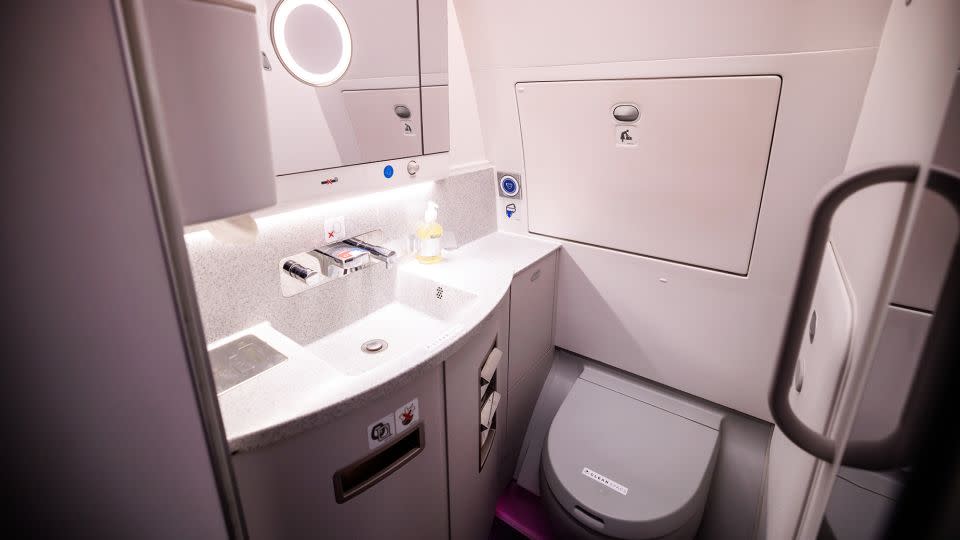
Using water to flush airplane toilets is a no go because of aircraft weight restrictions. No biggie; instead, planes use air.
The standard evac (evacuation) system uses differential air pressure to empty the bowl, in a design originally patented by James Kemper In 1975.
Waste tanks – where everything that goes down the toilet ends up – are usually located at the back of the plane, and often at the front, too.
When you press the flush button, a valve opens at the bottom of the toilet bowl, connecting it to a pipe below. That pipe – and the waste tank – are pressured, which means that opening the valve creates a vacuum that sucks out what’s in the bowl.
“It’s like your vacuum cleaner – it sucks,” says Nigel Jones, an aircraft engineering expert from Kingston University in London who also sits on the accreditation committee of the UK’s Royal Aeronautical Society.
“As you press the button, it opens the valve – and as soon as the valve opens, the suction draws it all out. Then the valve closes.”
That vacuum effect is going on continuously while the plane is in the air, says Jones – we just don’t hear it until we open the valve and connect the toilet to the system. When the plane is on the ground, however, the differential pressure isn’t there – meaning that the toilet flush is operated by a pump, which creates a vacuum in the tank. As the plane climbs into the air, and the differential pressure in the tank builds, the vacuum naturally forms and the pump stops.
Toilet bowls are Teflon coated. “So nothing sticks, and it doesn’t need much at all – the differential pressure clears everything mighty quickly,” says Jones.
Airlines choose how many toilets they want in a plane, and where they want them. Jones says that there are minimum numbers per aircraft, depending on size, but airlines can go above those if they want.
Of course, a tank that’s filled needs to be emptied – and this is where “honey wagons” come in.
These are airport servicing vehicles which empty the tank and take the contents to be processed on airport grounds.
It’s a well honed process with 50 years of history – so does that mean things will stay the same forever? Jamco, a Japanese company which currently has a 50% share of the aircraft toilet market, has already pushed boundaries, building onboard bidets for eight airlines including JAL, Al Nippon Airways and Oman Air. They were also first to introduce hygienic touchless flushes and faucets, on the Boeing 787.
A spokesperson for the company told CNN: “There are constraints in terms of space, safety requirements, and stringent certifications, making it challenging to introduce new technologies in aircraft interiors. However, we are continuously conducting workshops and discussions with various stakeholders to explore next-generation interior products.” In other words – watch this (small, suction-operated) space.
The myth of ‘blue ice’
Blue ice isn’t just something to be marveled at in Antarctica; it’s also the name given to accidental discharges of airplane sewage.
Airplanes have never deliberately shot their toilet waste into the atmosphere, not even in the old days, says Jones. But if a leak occurs in the discharge pipe, since mid-air temperatures are well below freezing, any fluid coming out automatically freezes.
“It would get to a point where it’s too heavy to adhere to the toilet servicing panel, so it would fall out and that’s what blue ice was,” he says.
This used to be more common until the 1980s, when legislation was introduced to ban taking off with any kind of leak in an aircraft’s toilet system.
Accidents still happen – in 2021, a resident near London’s Heathrow airport was “spattered” with excrement. Even worse, it wasn’t even frozen, since the plane was close to the ground and not in freezing temperatures. Luckily that’s a rare occurrence.
However, toilets do get blocked relatively often.
“It’s only a tiny pipe, and people put things like nappies down – I’ve seen cutlery go down, and [soft drink cans] – they’re fascinated to see whether it will go down or not,” says Jones, who used to work as an engineer for British Airways and saw some spectacularly plugged toilets.
But what seems like a harmless experiment can end up delaying your flight.
“It can take days to rectify because there’s an awful lot of pipework, and it has to be broken down to find the blockages,” says Jones. “If they have one or two blocked toilets, the aircraft is grounded because you have to have a certain number of toilets.”
Oh, and those stories that surface periodically about overflowing toilets? That’ll be because someone has blocked it but failed to report it – so the next time someone uses it, nothing goes down.
Hot stuff onboard
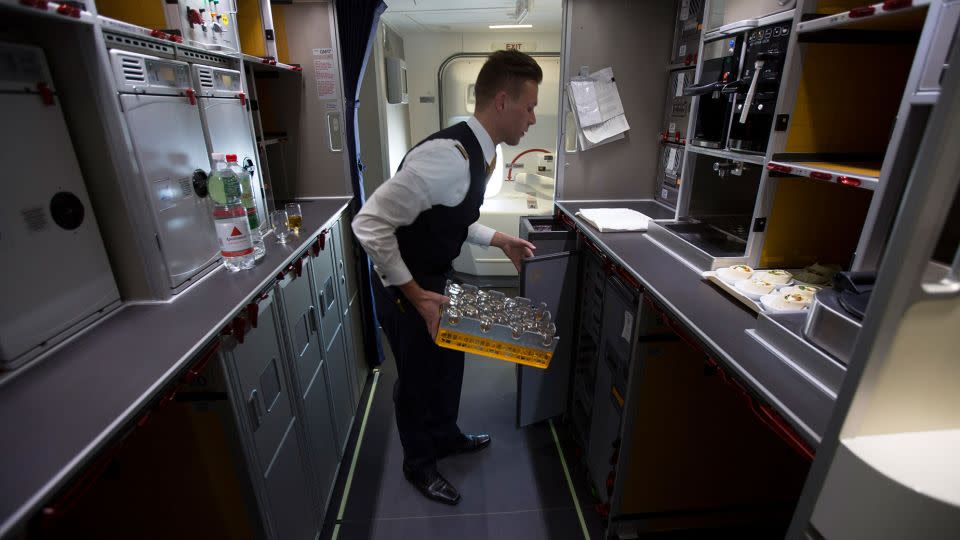
We’re all quick to criticize plane food, but as plane food enthusiast Nik Sennhauser says, “You have to take into account that you’re in a metal tube at 40,000 feet being catapulted through the air, and the flight attendant is heating up a meal in an oven.”
Prepping food to be served on a plane is a complex process with stringent hygiene regulations to be adhered to.
Dishes are prepared by catering companies usually based at the airport, before being loaded onto the aircraft. So far, so simple – until you think about having to heat hundreds of meals at the same time. Add in the fact that meals for longhaul flights are often frozen and it becomes even tricker.
Most airplane ovens can either use convection or steam to heat, says Jones – and can contain as many as 40 or 50 meals at a time. “On a large aircraft you could have maybe 10 or 12 ovens.” he says.
Overnight maintenance crews check that ovens are working as the plane sits on the ground overnight. One time they are kept completely off is during take-off.
“The aircraft needs all the power it can get from the engines to take off,” he says. “They don’t put the ovens on till they’re airborne because of the load on the electrical system. Once it’s cruising, it’s fine.”
Chillers and freezers run on a different circuit – so they never turn off. Just as well, since that would be a recipe for food poisoning.
Getting in hot water
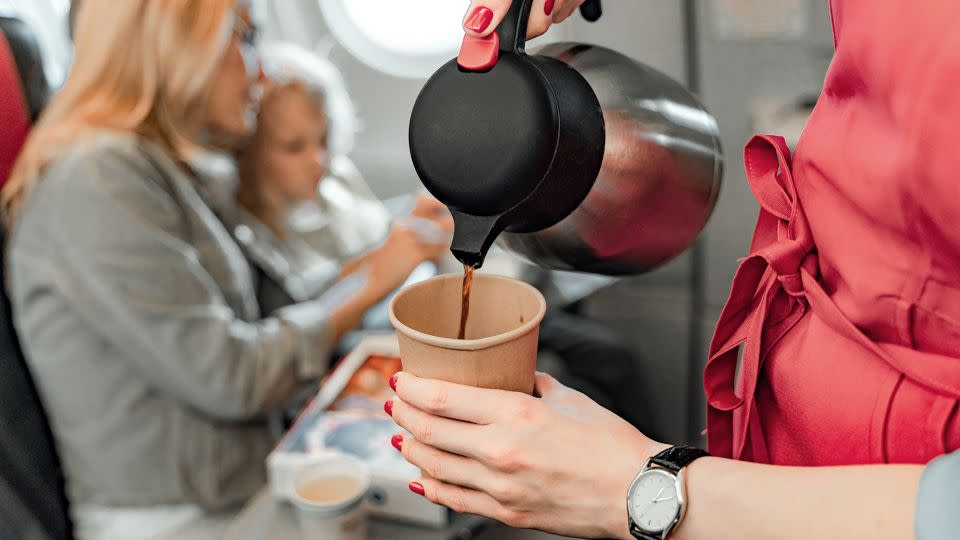
Have you ever heard advice not to drink tea or coffee on a plane?
A 2019 study of the drinking water on 11 major US carriers, which rated water from one to five, showed that only three scored a three or above – considered acceptable. Only one regional airline made the grade.
Non-bottled water is sourced from an onboard cold water tank, which provides water for the entire plane, from the toilets to the galleys.
The typical advice is to avoid coffee, tea and ice, but Jones is less bothered. Any hot water will have been heated to a point that kills most bacteria, and water is often treated before being added to the tank, he says. Water loaded onto a Boeing 787 is treated with UV light as it’s pumped aboard, for example.
Having said that, Jones adds, “The drink is only as good as the water that is provided.”
As for getting it nice and steaming, water from the tank is poured via a faucet and heated in “bev [beverage] makers” which heat the water and then keep it warm on hot plates.
Despite the grim warnings of “never drink coffee on a plane,” Kris Major, a flight attendant and chair of the European Transport Workers’ Federation Joint Aircrew Committee, says he’s not worried about downing water-based drinks onboard.
“I’m happy to drink water on the aircraft of my operator and – without being prejudiced because I’m only aware of the regulations in my part of the world – those in Europe and the UK,” he says.
“Any potable water should be fit for human consumption, and with tank-cleaning a requirement, there is no problem.”
Sky high Wi-Fi
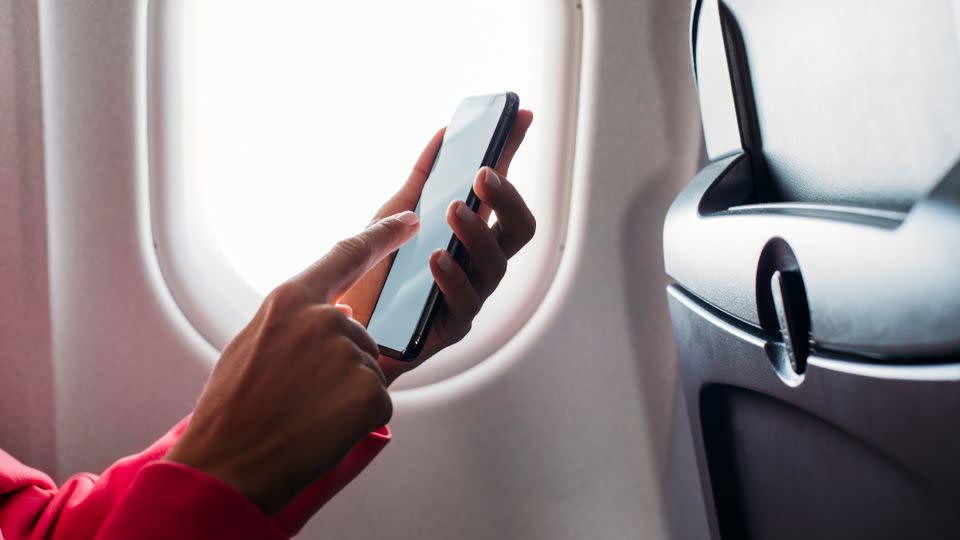
Many of us take internet access for granted in our daily lives. Some of us even take inflight internet access for granted. But just how easy is it to keep a connection going as you’re whizzing through the sky at 500 mph?
“It’s pretty easy technology – you have an antenna that sits on top of the aircraft and continually points at satellites in what’s called the geostationary arc,” says Don Buchman, general manager and vice president of commercial aviation at Viasat, which provides Wi-Fi for almost 10,000 flights per day at up to around 100 MB per second.
What sounds like easy tech for him – Buchman has an engineering background – sounds rather more complex for the rest of us, though.
Planes equipped for Wi-Fi with Viasat are receiving from satellites over 22,000 miles (36,000 kilometers) above the Earth, located along the equator.
Getting them up there – to levels called the “geostationary arc” or orbit – takes anything from 30 days to six months. But as Buchman says, once they’re in orbit, it’s simple. That high altitude means that each satellite can “see” about a third of the Earth, meaning you could technically fly around the globe connecting to just three satellites – although Viasat has 18.
Because each satellite covers such a vast area, it means that planes aren’t constantly disconnecting and reconnecting as they fly. Buchman says that a transcontinental US flight, for example, might use anything between one and all five of the Viasat satellites positioned nearest North America.
“Today we can do London to New York City on one, but it depends on the algorithm,” he says, referring to the algorithm Viasat uses to connect aircraft to the best satellite for the flight – bad weather might make the signal from one be better than another, for instance.
A Madrid-Rio de Janeiro flight, on the other hand, might cross two or three satellites, as it dips from the northern to southern hemisphere and crosses the Atlantic.
When the antenna disconnects from one satellite and links to another, Buchman wagers that passengers rarely notice.
“It’s almost always imperceptible – you don’t have to log back in, there’s no real break in connection. The worst [you’ll be offline] is a couple of seconds,” he says. Those longer pauses are if the satellites being used are far apart, meaning the antenna needs to repoint from east to west.
“Otherwise, it takes place almost instantly,” he says.
Speeds can technically reach over 100MB per seconds onboard, he says, but passengers normally experience around 20-40 MBPS. That’s enough for everyone onboard to individually stream Netflix, Buchman says. On the day of the Super Bowl, for example, Viasat estimates that around 100,000 watched it live on 1,800 flights over the four hours that it was showing. Buchman says that companies providing satellite Wi-Fi have to be prepared to operate at those levels.
“At hub airports – New York, Atlanta, Dallas, Chicago – you have every passenger online, all doing bandwidth-intensive communications. There’s a lot of demand.”
The antenna for inflight Wi-Fi doesn’t disturb the essential communications of the plane – Buchman says the tech goes through “rigorous, continuous certification.” The antenna is used only for the Wi-Fi, and usually sits in what’s known as a “ray dome” on top of the plane – “It looks like a hump,” says Buchman. Pilots can also use the Wi-Fi for non-safety-related communications and weather updates, but have a completely different system for essential communications.
And while inflight Wi-Fi feels commonplace today, Buchman says it’s a product of the last 20 years or so, kicked off by the launch of the iPhone – a product that, he says, “changed everything.”
“Inflight Wi-Fi was a culmination of high demand but at an affordable price, and a quality that was usable.” Viasat antennae have been flying the friendly skies since JetBlue installed Wi-Fi on its planes in 2013.
“Onboard connectivity was nice to have 15 years ago – now it’s table stakes,” says St. Germain. British Airways would agree – just this past week, the airline announced free inflight messaging for passengers as part of a $9 billion service upgrade. It joins major airlines including LATAM, Iberia and Southwest in offering free texting services for its passengers. In the US, JetBlue and Delta are leading the free Wi-Fi charge, says Buchman, with American Airlines close behind.
Fresh air at 40,000 feet
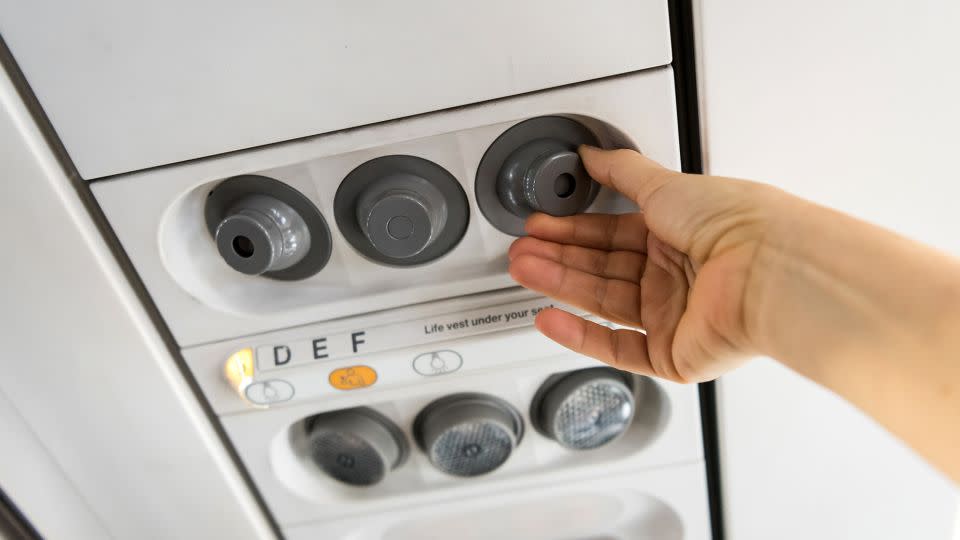
It wasn’t just travel restrictions that stopped people traveling when the pandemic started; for many, the idea of sitting in close proximity to strangers who might be harboring disease meant they had no intention of taking a flight, whether or not they were allowed.
That’s when airlines – which usually concentrate on publicizing their inflight entertainment and fancy seats – started talking about HEPA filters. These air filters – HEPA stands for “high efficiency particulate air” – are standard in two environments: aircraft and operating rooms. According to the US government’s Environmental Protection Agency, they can remove “at least 99.97% of dust, pollen, mold, bacteria, and any airborne particles with a size of 0.3 microns.”
While many people think the air on a plane is constantly blown around the cabin, Jones says that modern aircraft circulate air in a different way.
“In the old days, aircraft used to take air from the engines, so it had to be cooled through through an air conditioning pack,” he says.
But newer aircraft – such as the Boeing 787 – don’t use “engine bleed” air. Instead, they have onboard compressors – “one for each ECS, or environmental control system,” says Jones.
They take air from an external source and run it through the compressor. The ECS then circulates the air through the cabin, refining it with HEPA filters. Each cabin runs on a different system, meaning crew can turn down the heating in business class if those lie-flat beds are feeling a bit too cozy, but leave economy passengers warm in their thinner blankets.
The onboard air circulation of today isn’t just about keeping healthy – it also controls how passengers feel, especially on longhaul flights. “On a 787 the air is changed every three minutes – completely new air – and on the [Airbus] A350 it’s every two to three minutes, with precisely controlled temperature and humidity to make you feel fresh when you get to your destination,” says Jones. It makes a genuine difference, as anyone who’s taken one leg on an older aircraft such as a Boeing 777, followed by the next on a newer aircraft, can attest.
“You feel different when you get off – you don’t feel as jet lagged as you thought you might,” says Jones of the newer aircraft.
While most people traveling for their hard-earned vacation still book flights depending on the route and price, St. Germain says that small inflight details make a big difference to frequent flyers.
“If you’re a road warrior out there 30-40 times a year, it’s about overall experience. That’s where things like meal quality, leg room and onboard connectivity start to play into the experience,” he says.
“In the past decade we’ve seen a push for a better product than we saw in prior years.
“Airlines are understanding that products can play into the purchase decision more than it has before.”
For more CNN news and newsletters create an account at CNN.com

